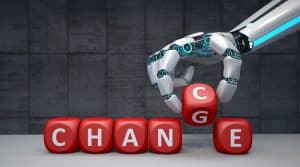
The remote working era may be an aberration in the way we work, but it’s a reality we are living with, and changes must take place. As such, your change management strategy is critical.
Even when 70% of changes fail may still be subject to a lot of debate, one certain thing is that changes will fail when organizations fail to plan properly and when there is no efficient change management strategy. Situations such as the unexpected mass shift of employees to remote working can really disrupt change management initiatives. Increasingly, this requires efficient change management.
Why? The COVID-19 pandemic was an ill wind, and it did not blow anybody any good. Businesses, governments, and individuals are still reeling from its devastating effects. Changes and dramatic ones, such as remote service and condition monitoring, have now become a necessity; in the wake of these dramatic changes came unprecedented risks and cybersecurity issues.
While all these are glaring, any organization that has previously put in place an efficient change management strategy may not have been hit so badly. In this era of remote working and based on the fact that a lot of employees have indicated interest to continue with remote working even after the world must have been able to find the solution to the pandemic, you need to come up with effective change management strategies to enhance change management.
Change management embraces all the ways you can prepare, support, and help teams, employees, and your organization to go through change, can be initiated by any of the following:
- Emerging technologies
- Revamping legacy systems
- Layoffs
- Mass hiring
- Response to crisis
- Improving customer experience
- Gaining relevance and competitive advantage
- Acquisitions and mergers
- Restructuring the managerial level
The change you want to embark upon may necessitate redirection of budgets, human and financial resources, processes, and operations. If your aim is just to handle the change of personnel and teams, you can concentrate on change management, but when you have to embark on the total organizational change of the whole business, you will need to focus on organizational change management.
Whichever of the two you are progressing with, your ultimate goal will be leveraging a strategic approach to move your business operations and processes to a higher level to add more value to your customers and the organization.
Change management strategy
Without a change management strategy, you will embark on change that has not got a roadmap, and it will hardly be beneficial to your customers and the organization. Apart from that, your employees will not have the right focus; your resources will be wasted in the long run.
A well-defined strategy specifies the aim, goal, purpose, and direction you want the change to follow. It defines the features and characteristics of the change; the timeframe, risks, limitations, potential resistance from employees, and how the change will progress will be well-spelled out.
A change management strategy enhances an easy transition for everybody that has a role to play in the change initiative. No two changes are the same, hence you must have a strategy for all the different types of changes.
For instance, the change management strategy you need for replacing senior leadership in the remote working era can never be the same as deploying new technologies to ensure that your remote workforce can collaborate easily.
Any change has its processes, challenges, and attendant risks. Your strategy must look into how the change will affect your employees, the ease of adoption, and the feasibility of utilization.
Design a change management strategy
Now that you have seen the need for a change management strategy, the next step is to design one. However, you must know what you want to achieve, and you can help the organization to move at a good speed with the change management strategy by clearing some knotty points.
1. Map out the features of the change
A good step to quickly mapping out the features or characteristics of the change management strategy is to prepare a list of questions you must provide answers to; the following can be your guide:
- Have you determined the extent of the change?
- Is the change targeted at employees, customers, the supply chain, or the organization?
- Do you know the number of people the change will affect?
- How do you intend to carry along everybody the change will impact?
- Is everybody on the same page with the change?
- What precisely do you want to change?
- Do you have a timeframe for the completion of the change?
Candid answers to these questions will help you to focus on the strategy you want to design.
2. An in-depth knowledge of your organization
A good change management strategy for the remote working era must have an inward look at how the organization runs. The history and organizational culture are critical to the strategy you want to design.
You must have good reasons that warrant the need for this change now that your organization is remote working.
To what extent do your managers and employees believe in this change? If you have carried out some changes previously, who managed them? How successful were the changes you carried out before embarking on remote working? Does everybody in the organization have a common goal? Are you currently carrying out any change in the organization? How flexible is your organizational culture?
In-depth knowledge of what goes on in your organization places you on a good footing to design a change management strategy.
The next step is to actually create your change management strategy, but you must take cognizance of the following powerful things that must feature strongly in your strategy.
Team structure
Your strategy must explicitly specify the roles of the project team and the change management team; often, there is confusion about who plays a particular role. If this is not specified, your change initiative may get stalled.
There must be a leader, most probably from the project team, in the change management team who ensures a smooth relationship between the two teams. It will ease friction out if your strategy defines responsibilities and also takes care of resources.
Sponsor coalition
There is usually a main sponsor who authorizes and initiates the change; this individual may not be able to singularly oversee the change, especially where the change cuts across different departments and sections of the organization. To enhance a smooth flow of the change project, the main sponsor forms a sponsor coalition of stakeholders that will include members of the C-suite and departmental heads.
If the change does not impact every department, it’s advisable to pick your sponsor coalition from the sections that will be directly affected by the change. These leaders must be people who your employees can trust and will influence their decisions.
This is important to mitigate frictions that arise from a lot of change projects. An effective communication channel is of high essence.
Conclusion
The remote working era may be an aberration in the way we work, but it’s a reality we are living with, and changes must take place. Your change management strategy is critical at this point, and it ensures you pinpoint risks and areas resistance may arise from at the onset and be proactive about resolving such issues.
When you have a change management strategy, it becomes relatively easier to fashion out a plan. The plan will include essential details such as the extent of the change, the budget you need, how to ensure collaboration among teams, and the expected time of conclusion.





























